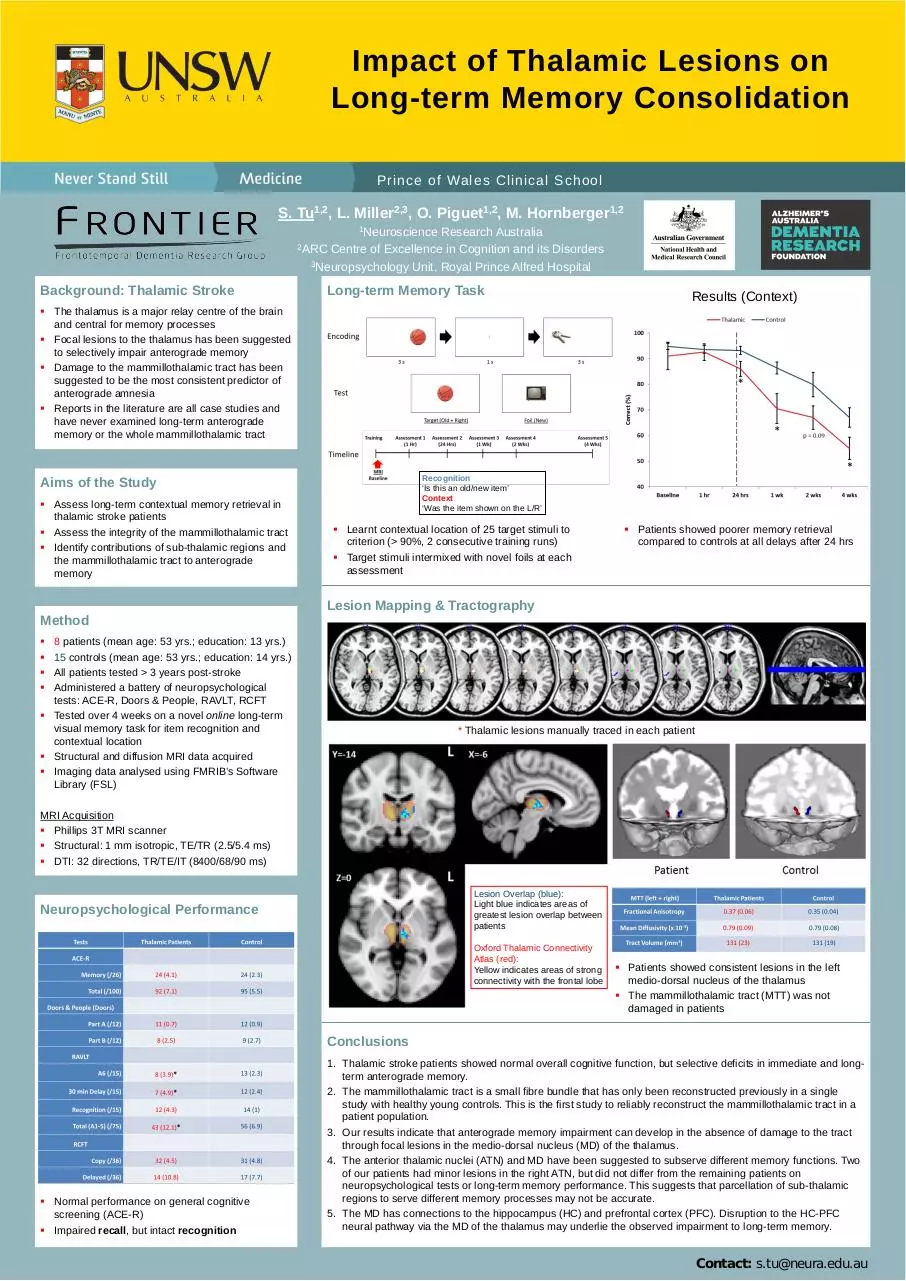sfn2013 poster (PDF)
File information
Title: Slide 1
Author: z9100677
This PDF 1.5 document has been generated by Acrobat PDFMaker 10.1 for PowerPoint / Adobe PDF Library 10.0, and has been sent on pdf-archive.com on 21/11/2013 at 01:18, from IP address 129.94.x.x.
The current document download page has been viewed 524 times.
File size: 539.13 KB (1 page).
Privacy: public file

File preview
Impact of Thalamic Lesions on
Long-term Memory Consolidation
Prince of Wales Clinical School
S. Tu1,2, L. Miller2,3, O. Piguet1,2, M. Hornberger1,2
1Neuroscience
Research Australia
2ARC Centre of Excellence in Cognition and its Disorders
3Neuropsychology Unit, Royal Prince Alfred Hospital
Background: Thalamic Stroke
Long-term Memory Task
Results (Context)
The thalamus is a major relay centre of the brain
and central for memory processes
Focal lesions to the thalamus has been suggested
to selectively impair anterograde memory
Damage to the mammillothalamic tract has been
suggested to be the most consistent predictor of
anterograde amnesia
Reports in the literature are all case studies and
have never examined long-term anterograde
memory or the whole mammillothalamic tract
Recognition
‘Is this an old/new item’
Context
‘Was the item shown on the L/R’
Aims of the Study
Assess long-term contextual memory retrieval in
thalamic stroke patients
Assess the integrity of the mammillothalamic tract
Identify contributions of sub-thalamic regions and
the mammillothalamic tract to anterograde
memory
Learnt contextual location of 25 target stimuli to
criterion (> 90%, 2 consecutive training runs)
Target stimuli intermixed with novel foils at each
assessment
Patients showed poorer memory retrieval
compared to controls at all delays after 24 hrs
Lesion Mapping & Tractography
Method
8 patients (mean age: 53 yrs.; education: 13 yrs.)
15 controls (mean age: 53 yrs.; education: 14 yrs.)
All patients tested > 3 years post-stroke
Administered a battery of neuropsychological
tests: ACE-R, Doors & People, RAVLT, RCFT
Tested over 4 weeks on a novel online long-term
visual memory task for item recognition and
contextual location
Structural and diffusion MRI data acquired
Imaging data analysed using FMRIB’s Software
Library (FSL)
* Thalamic lesions manually traced in each patient
MRI Acquisition
Phillips 3T MRI scanner
Structural: 1 mm isotropic, TE/TR (2.5/5.4 ms)
DTI: 32 directions, TR/TE/IT (8400/68/90 ms)
Lesion Overlap (blue):
Light blue indicates areas of
greatest lesion overlap between
patients
Neuropsychological Performance
Oxford Thalamic Connectivity
Atlas (red):
Yellow indicates areas of strong
connectivity with the frontal lobe
Patients showed consistent lesions in the left
medio-dorsal nucleus of the thalamus
The mammillothalamic tract (MTT) was not
damaged in patients
Conclusions
Normal performance on general cognitive
screening (ACE-R)
Impaired recall, but intact recognition
1. Thalamic stroke patients showed normal overall cognitive function, but selective deficits in immediate and longterm anterograde memory.
2. The mammillothalamic tract is a small fibre bundle that has only been reconstructed previously in a single
study with healthy young controls. This is the first study to reliably reconstruct the mammillothalamic tract in a
patient population.
3. Our results indicate that anterograde memory impairment can develop in the absence of damage to the tract
through focal lesions in the medio-dorsal nucleus (MD) of the thalamus.
4. The anterior thalamic nuclei (ATN) and MD have been suggested to subserve different memory functions. Two
of our patients had minor lesions in the right ATN, but did not differ from the remaining patients on
neuropsychological tests or long-term memory performance. This suggests that parcellation of sub-thalamic
regions to serve different memory processes may not be accurate.
5. The MD has connections to the hippocampus (HC) and prefrontal cortex (PFC). Disruption to the HC-PFC
neural pathway via the MD of the thalamus may underlie the observed impairment to long-term memory.
Contact: s.tu@neura.edu.au
Download sfn2013 poster
sfn2013_poster.pdf (PDF, 539.13 KB)
Download PDF
Share this file on social networks
Link to this page
Permanent link
Use the permanent link to the download page to share your document on Facebook, Twitter, LinkedIn, or directly with a contact by e-Mail, Messenger, Whatsapp, Line..
Short link
Use the short link to share your document on Twitter or by text message (SMS)
HTML Code
Copy the following HTML code to share your document on a Website or Blog
QR Code to this page

This file has been shared publicly by a user of PDF Archive.
Document ID: 0000135884.